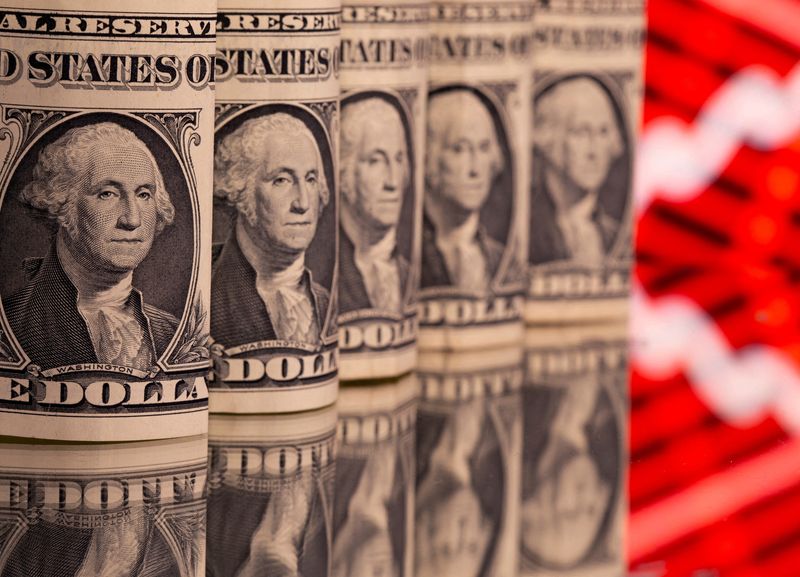Forex
Dollar down on profit taking but upbeat outlook remains

By Saqib Iqbal Ahmed
NEW YORK (Reuters) -The dollar slipped against most major currencies on Friday as traders booked profits after recent gains but the U.S. currency remained well-placed for further advances, supported by strong U.S. economic data that has prompted markets to dial back expectations for interest rate cuts.
Data on Friday showed new orders for key U.S.-manufactured capital goods rebounded more than expected in April and shipments of these goods also increased, suggesting a pickup in business spending on equipment early in the second quarter.
This follows Thursday’s data that showed U.S. business activity in May accelerated to the highest level in just over two years and manufacturers reported surging input prices.
Minutes from the Federal Reserve’s last meeting published this week showed a lively debate among policymakers as to whether current rates were sufficiently restrictive to cool inflation.
The dollar was down 0.3% at 104.72 against a basket of currencies on Friday, after advancing in five of the last six trading sessions. For the week the index was up 0.2%.
The euro was up 0.3% at $1.08495 late on Friday.
“Investors are just now taking the opportunity to reflect back on the week and take some profits … it’s really purely a positioning play,” said Boris Kovacevic, global market strategist at payments company Convera in Vienna.
While stronger-than-expected U.S. economic data has led traders to push out the timing of the first Fed rate cut to September, expectations for rate cuts by other central banks have also slipped.
“For as much as expectations of easing from the Federal Reserve have cooled off over the last week, it’s a similar story for central bankers around the world – ECB rate cut changes have also downshifted after lots of official commentary since Monday,” said Helen Given, FX trader at Monex USA in Washington.
Despite Friday’s retreat, the near-term outlook for the dollar was upbeat, analysts said.
“This theme of the U.S. exceptionalism is still playing out,” Convera’s Kovacevic said.
The dollar is up almost 1% this week on the Japanese yen to 156.95 yen, even though Japanese government bond yields have climbed too, scaling decade highs and clearing 1% at the 10-year tenor. [JP/]
Japan’s core inflation slowed for a second straight month in April, meeting market expectations – and staying above the central bank’s target – at 2.2%.
“It’s having very little effect on the yen,” said Martin Whetton, head of financial markets strategy at Westpac in Sydney. “The carry of holding dollars is far juicier,” he said, while policymakers’ rhetoric has also made traders nervous about inflation and the risk rate cuts would be distant or small.
The pound rose 0.3% to $1.27365 on Friday.
Data showed wet weather hit UK consumer spending far more than expected in April, but evidence of sticky inflation, and the surprise announcement this week of a July general election kept sterling near two-month highs.
China started a second day of war games around Taiwan. held steady in the offshore market around 7.2627.

The New Zealand dollar was up 0.4% at $0.61225, underpinned by a hawkish shift in outlook from the Reserve Bank of New Zealand.
Among cryptocurrencies, ether was about flat at $3,735.90, on Friday, a day after the U.S. Securities and Exchange Commission approved applications from Nasdaq, CBOE and NYSE to list exchange-traded funds (ETFs) tied to the price of ether, potentially paving the way for the products to begin trading later this year. For the week, ether is up about 20%.

 Forex3 years ago
Forex3 years agoForex Today: the dollar is gaining strength amid gloomy sentiment at the start of the Fed’s week

 Forex3 years ago
Forex3 years agoUnbiased review of Pocket Option broker

 Forex3 years ago
Forex3 years agoDollar to pound sterling exchange rate today: Pound plummeted to its lowest since 1985

 Forex3 years ago
Forex3 years agoHow is the Australian dollar doing today?

 Cryptocurrency3 years ago
Cryptocurrency3 years agoWhat happened in the crypto market – current events today

 World3 years ago
World3 years agoWhy are modern video games an art form?

 Commodities3 years ago
Commodities3 years agoCopper continues to fall in price on expectations of lower demand in China

 Economy3 years ago
Economy3 years agoCrude oil tankers double in price due to EU anti-Russian sanctions





















